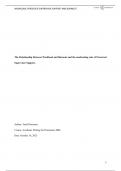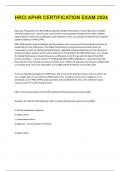WORKLOAD, PERCEIVED SUPERVISOR SUPPORT AND BURNOUT
The Relationship Between Workload and Burnout and the moderating role of Perceived
Supervisor Support.
Author: Yentl Driessens
Course: Academic Writing for Premasters HRS
Date: October 16, 2023
1
, WORKLOAD, PERCEIVED SUPERVISOR SUPPORT AND BURNOUT
The Relationship Between Workload and Burn out and the moderating role of Perceived
Supervisor Support
Burnout is a chronic work-related disease that causes mental and physical exhaustion
due to imbalances between high demands and low resources (Bakker, et al., 2005). During the
COVID-19 pandemic, employees experienced higher work-related stress levels which lead to
an increased risk of burnout. Against this background, recent literature has given more
attention to the interaction between stress levels and burnout (Gabriel & Aguinis, 2022). The
relevance of research into burnout is also currently visible, as the study among hospital
consultants in Ireland shows that almost half of the respondents reported high levels of
burnout (Crudden et al., 2023). As a result for employees, burnout can lead to long-term
effects, such as a higher risk of severe injury problems (Ahola et al., 2013) and a greater risk
of psychological disorders (Ahola & Hakanen, 2007). On organizational level, burnout can
lead to lower productivity and reduced commitment, effectiveness, and job satisfaction
(Demerouti et al., 2021).
There are various job demands that predict the level of burnout, such as time pressure,
workload, stressful working environment and emotional labor (Bakker et al., 2023). The
present research focuses on the relationship between workload and burnout. As a theoretical
foundation, the Job Demands-Resource model provides support for this relationship (Bakker
& Demerouti, 2017). The JD-R-model describes that burnout occurs when there are high job
demands and limited resources for the employee in the workplace (Bakker & Demerouti,
2017; Bakker & Costa, 2014). Although job demands are an important part of every job, job
demands can cause serious problems if they are not balanced by job resources. The direct
relationship between workload and burnout can be explained by observing the imbalance that
arises when there is too much workload. This imbalance causes work stress and leads to
burnout (Demerouti et al., 2001). Several studies examined this relationship, such as the study
2






